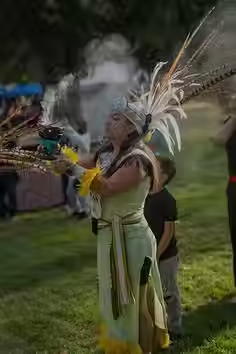

RUSSIAN FOLK DANCE
Russian folk dances blend modesty, decency, and eroticism. They feature women in dresses that highlight their beauty and restrained yet graceful gestures. Men's dances can include floor movements absent in women's dances, symbolizing respect and admiration. In these dances, a man might lift a woman, showcasing his emotion and strength.
PHILIPPINES
Traditional Philippine dance represents the rich cultural heritage and diverse history of the Filipino people. From the graceful movements of Tinikling, which mimic birds evading bamboo traps, to the powerful tribal dances of the indigenous mountain regions, these dances reflect stories of everyday life, spirituality, colonial resistance, and celebration. Philippine dance is more than performance—it's a living expression of identity, unity, and the enduring spirit of a people shaped by nature, history, and tradition.
AZTEC DANCE/CEREMONY
The vibrant dance honors the six directions and involves burning Sage and Copal for blessings. Dancers wear striking regalia with feathers, bright colors, and rattles made of nuts and seeds. Originating from various parts of Mexico, the dance movements act as prayers connecting with the Universe. Accompanied by drums and rattles, the music and dance pay homage to nature and celebrate indigenous traditions.
Belly Dance
Belly dance is a traditional Middle Eastern dance form known for its fluid, expressive movements of the hips and torso. Rooted in the cultures of Egypt, Turkey, and other Arab regions, it is often performed at celebrations and gatherings. Belly dance celebrates femininity, storytelling, and rhythm, passed down through generations as both an art form and a cultural expression.
NATIVE AMERICAN
The Native American grass dance mimics wind-swayed grass, emphasized by dancers' headdresses, fringes, and ribbons. Some grass dances prepare grounds for ceremonies by flattening grass, symbolizing victory over foes. Dance is vital for Native Americans, connecting them and preserving their unique cultures. Drums, symbolizing Earth's heartbeat, play a pivotal role in their rituals, helping connect with the Great Spirit.
IRISH
Irish music is a vibrant and soulful tradition rooted in storytelling, community, and celebration. Known for its lively jigs and reels as well as haunting ballads, Irish music features instruments like the fiddle, tin whistle, bodhrán (drum), and uilleann pipes. Passed down through generations, it reflects the resilience, history, and spirit of the Irish people, often evoking themes of love, nature, struggle, and joy. Whether upbeat or reflective, Irish music brings people together and continues to influence folk and contemporary music worldwide.
TAHITIAN/HULA
Tahitian dance, or Ori Tahiti, originated in Tahiti, French Polynesia, and has been integral to the region for thousands of years. Historically, dances served various purposes: attracting lovers, challenging enemies, religious worship, or prayer. This dance form, deeply rooted in Polynesian traditions, initially represented the movement and life of the Tahitian people and was passed down orally.
MEXICAN/MARIACHI
Mariachi has both traditional and modern forms. Traditional mariachi features mestizo and indigenous groups using instruments like guitar, violin, harp, and vihuela, dressed in peasant attire. Modern mariachi, known globally, typically comprises at least three members using guitar, guitarrón, violin, and trumpets, sometimes incorporating flute, harp, or accordion. Their repertoire ranges from rancheras to boleros rancheros and corridos, often dressed in black or white.

























